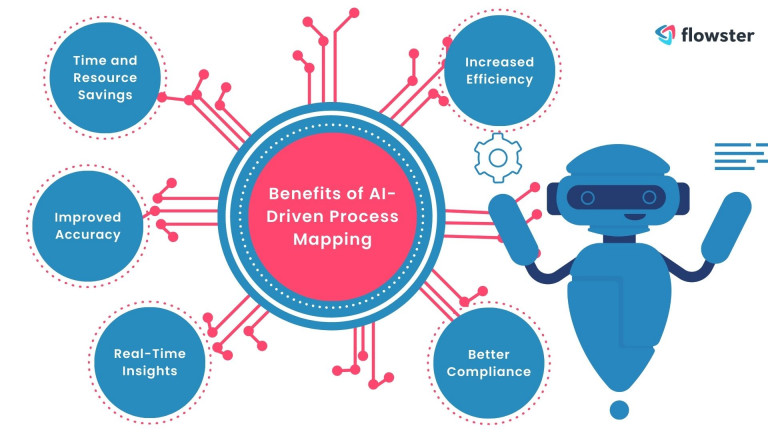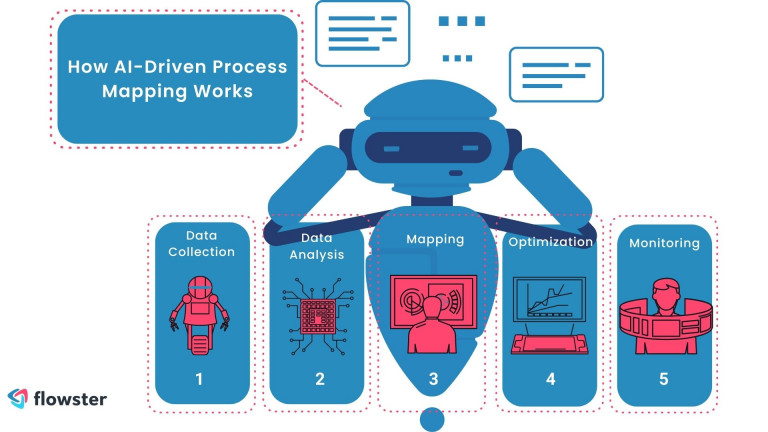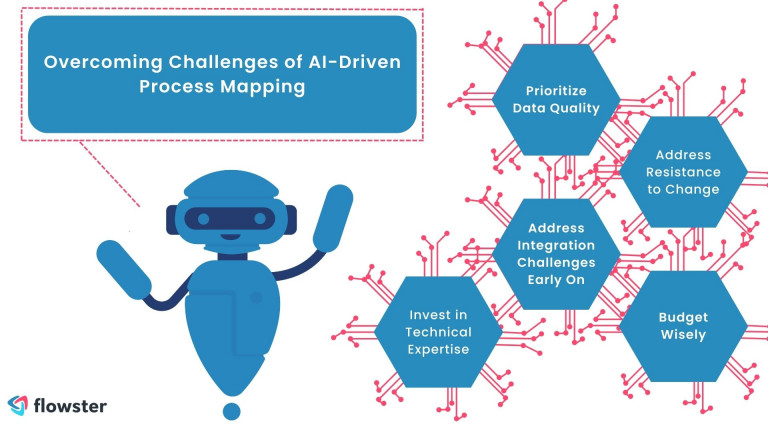Do you ever get frustrated with how long and complicated your business operations take? Are you looking for ways to streamline these processes and improve efficiency? Look no further than AI-driven process mapping.
In this article, we’ll talk about how AI-driven process mapping is a new kind of technology that can change how businesses optimize their processes. We’ll discuss the benefits of this technology, including time and resource savings, improved accuracy, and up-to-date process maps.
We’ll also talk about how AI-driven process mapping is used in the real world, including in the healthcare, manufacturing, finance, and customer service industries. We’ll also talk about the problems that come with using this technology for business outcomes and the ways that businesses can solve them.
So, if you’re interested in learning more about how AI-driven process mapping can revolutionize your business processes, keep reading. We’ve got everything you need to know.
Article Outline
What is AI-Driven Process Mapping?
Have you ever heard of “AI-driven process mapping” and wondered what it actually means? Simply put, it is a revolutionary technology that uses artificial intelligence to map out and improve complex business processes.
AI-driven business process management mapping uses machine learning algorithms and data analysis to find inefficiencies, bottlenecks, and places where your business processes could be better. This technology can save you time, money, and headaches by automating boring and error-prone mapping tasks that you used to have to do by hand.
But that’s not all: AI-driven process mapping also provides real-time insights and up-to-date process maps, which can help businesses stay agile and adapt to changing circumstances.
In short, AI-driven process mapping is an innovative technology that can revolutionize the way you approach process optimization in your business or organization.

The Benefits of AI-Driven Process Mapping
AI-driven process mapping offers numerous benefits for businesses of all sizes and industries. Let’s take a closer look at each one.
Time and Resource Savings
One of the biggest advantages of AI-driven process automation for mapping is the time and resource savings it provides. Businesses can save valuable time and resources that can be put toward more productive tasks if they can have machine learning systems automate mapping processes and quickly find places to improve.
Improved Accuracy
AI-driven process mapping gives a level of accuracy that is hard to get with manual mapping. Using algorithms for machine learning and data analysis, this technology can find patterns and places for process improvement that people might miss.
Real-Time Insights
With up-to-date process maps and real-time insights, businesses can stay agile and adapt to changing circumstances quickly. This can help organizations make decisions based on good information and improve their processes quickly.
Increased Efficiency
AI-driven process mapping can help businesses improve their efficiency and productivity by pointing out where existing processes aren’t working well or where they get stuck. This can lead to more money in the bank, happier customers, and a better position in the market.
Better Compliance
Businesses can make sure they are meeting regulatory requirements and avoid expensive fines and penalties by being able to find compliance issues and monitor processes in real time.
AI-driven process mapping has many benefits for businesses that want to improve their operations and efficiency and streamline their processes. From time and resource savings and costs to increased accuracy and real-time insights, this technology can help organizations stay ahead of the competition and achieve their goals.
How AI-Driven Process Mapping Works
AI-driven process mapping is a series of steps that use machine learning algorithms and data analysis to map out and automate processes to improve complex business processes. Let’s take a closer look at each artificial intelligence process map step.

Step 1: Data Collection
The first step in AI-driven process mapping is to collect data about the process being mapped. This can include process documentation, logs, and other relevant data sources to analyze processes.
Step 2: Data Analysis
Once the data has been collected, machine learning algorithms are used to look at it and find patterns and problems in the way the content creation itself is made.
Step 3: Mapping
After finding patterns and inefficiencies in operations, AI-driven process mapping tools make process maps that show how the given business process works and point out places where it can be improved.
Step 4: Optimization
Once the process maps are created, the next step in digital transformation is to optimize the workflow process. This can include automating certain steps, removing redundancies, and streamlining workflows.
Step 5: Monitoring
The last step of AI-driven process mapping automation and improvement efforts is to keep an eye on the process in real time to make sure it keeps working well. This can include setting up alerts for potential issues and monitoring key performance indicators.
In summary, AI-driven business process management mapping is a powerful technology that uses data analysis and machine learning algorithms to map out and improve complex business processes. By following the steps of the data collection process—mining, analysis, mapping, optimization, and monitoring—organizations can improve their efficiency, save valuable time and resources, and stay ahead of the competition.
Transform Your Business Processes with Flowster's AI-Driven Automation
Real-World Applications of AI-Driven Process Mapping
AI-driven process mapping has numerous applications in various industries. Here are some examples:
Healthcare: AI-powered process mapping solutions can help hospitals and clinics improve how they schedule appointments, keep track of patient records, and bill patients.
Manufacturing: AI-driven process mapping can improve manufacturing processes like inventory management, supply chain management, and quality control.
Finance: AI-driven process mapping can make it easier for banks to do things like approve loans, manage accounts, and find fraud.
Customer service: Ticketing systems, call centers, and chatbots can all be improved with AI-driven process analysis and mapping.
Challenges of Implementing AI-Driven Process Mapping
AI-driven process mapping has a lot of benefits for businesses, but putting it to use can be hard in some ways. Let’s take a closer look at each challenge.
Data Quality
One of the hardest parts of AI-driven process mapping is making sure that the data being used is accurate and of good quality. This requires businesses to have a clear understanding of their data sources and ensure that the data is up-to-date and relevant.
Technical Expertise
Implementing AI-driven process mapping requires a certain level of organization and technical expertise. Businesses may need to buy specialized tools and hire experts to help them create and manage the process of putting the plan into action.
Integration with Existing Systems
Integrating AI-driven process mapping with existing systems and processes can also be a challenge. This means that businesses need to make sure that the different technologies work well together and fix any integration problems that might come up.
Resistance to Change
Some employees may be resistant to change and may be hesitant to adopt new technology. This can slow down the implementation process and make it more challenging to achieve the desired results.
Cost
Lastly, using AI to map out processes can be expensive, especially for small businesses and companies with limited funds. This needs to be carefully planned and budgeted to make sure that the investment will pay off.
In conclusion, putting AI-driven process mapping into place can be difficult, but the benefits are well worth the trouble. Businesses can use this technology successfully and get more efficiency, better accuracy, and real-time insights by fixing problems with data quality, technical expertise, system integration, resistance to change, and cost.

Overcoming the Challenges of Implementing AI-Driven Process Mapping
Let’s take a look at some strategies businesses can use to overcome these aspects of the challenges of implementing AI-driven process mapping solutions.
Prioritize Data Quality
To make sure that the data used in AI-driven process mapping is correct and of good quality, businesses should give data governance a high priority and invest in tools for data management. This means that data sources need to be checked often, data needs to be cleaned and organized, and data needs to be updated in real-time.
Invest in Technical Expertise
Businesses may need to buy specialized automation tools and hire experts to help them manage the process of putting AI-driven process mapping in place. This could mean working with consultants or business analysts from outside the company or spending money on training for current employees.
Address Integration Challenges Early On
Businesses should deal with integration problems and monitoring tools early on to make sure they can work well with existing systems. This includes figuring out how well different technologies work together as is processes, dealing with any possible integration problems, and making a plan for moving data.
Address Resistance to Change
To deal with employees who don’t want to change, businesses should include them in the process and give them the right training and support. This means telling people about the benefits and power of AI-driven process mapping and showing how it can make everyday tasks faster and more accurate.
Budget Wisely
AI-driven process mapping can be expensive to implement, so businesses should plan their budgets carefully to ensure they get a good return on their investment. This includes making a detailed plan and budget, putting activities in order of importance, and checking on progress often to ensure that resources are being used well.
By using these methods in practice, businesses can successfully use AI-driven process mapping and predictive analytics and deal with the problems that come with them.
Businesses can get the most out of this technology and stay ahead of the competition if they put data quality first, invest in technical expertise, deal with integration challenges, deal with resistance to change, and plan their budgets well.
FAQs on AI-Driven Process Mapping
Is AI-driven process mapping suitable for all types of businesses?
- Yes, AI-driven process mapping can be applied to any business process, regardless of the industry.
How can companies ensure that the process maps made by AI-driven process mapping are correct?
- Businesses can make sure their process maps are correct by investing in tools for data cleaning and preprocessing and reviewing their data often.
Are there any privacy concerns associated with implementing AI-driven process mapping?
- Yes, businesses must make sure that the information they collect is safe and that no one else can get to it.
Does implementing AI-driven process mapping require specialized expertise?
- Yes, implementing AI-driven process mapping requires expertise in data analysis and machine learning.
What are the benefits of using AI-driven process mapping?
- AI-driven process mapping can save time and money, improve accuracy, make process maps more complete, and keep process maps up to date.
Conclusion
In conclusion, AI-driven process mapping is changing the way businesses work by making it easier, faster, and more accurate to manage and improve workflows. AI-driven process mapping has many benefits for businesses of all sizes and types. For example, it can automate routine tasks, find bottlenecks, and improve performance.
However, as with any technology, implementing AI-driven process mapping can come with its own set of challenges. Some of these problems are bad data, a lack of technical expertise, problems with integration, resistance to change, and limited budgets.
Businesses can successfully use AI-driven process mapping and stay ahead of the competition by addressing these challenges early on and following the strategies in this article.
We hope that this article has provided you with valuable insights and a deep understanding of the benefits and challenges of AI-driven process mapping. If you have any comments, questions, or additional insights to share, we would love to hear from you in the comments section below.
Ready to Create Your First AI-Driven Process Map?
Start from scratch to make a process map or workflow template, or look through our templates in Flowster’s Marketplace.
Want help? Use our “Done for You” service to let our experts build custom workflows for you.
Related Articles
Would you like to learn more? See our other informative articles.
How Flowster’s New AI Feature is Supercharging Your Workflow Efficiency
What Process Management Tool Is Right For You? Flowster vs Alternatives


